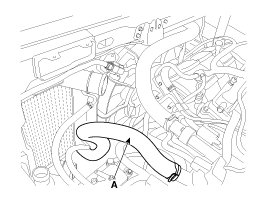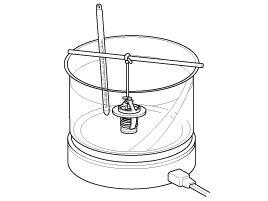 Kia Sportage: Thermostat: Repair procedures
Kia Sportage: Thermostat: Repair procedures
Third generation SL (2010–2016) / Kia Sportage SL Service & Repair Manual / Engine Mechanical System / Cooling System / Thermostat: Repair procedures
| Removal and Installation |
Disassembly of the thermostat would have an adverse effect,
causing a lowering of cooling efficiency. Do not remove the thermostat,
even if the engine tends to overheat. |
| 1. |
Drain engine coolant so its level is below thermostat. |
| 2. |
Disconnect the radiator lower hose (A).
|
| 3. |
Remove water inlet fitting (C), gasket (B) and thermostat (A).
|
| 4. |
Installation is reverse order of removal.
|
| 5. |
Fill the engine coolant. |
| 6. |
Start the engine and check for leaks. |
| 7. |
Recheck the coolant level. |
| Inspection |
| 1. |
Immerse thermostat in water heated to over 95°C (203°F), then heat for at least 3 minutes to check valve lift.
|
| 2. |
Check the valve opening temperature.
If the valve opening temperature is not as specified, replace the thermostat. |
| 3. |
Check the valve lift.
If the valve lift is not as specified, replace the thermostat. |
 Water pump: Troubleshooting
Water pump: Troubleshooting
Troubleshooting
Water Pump
SymptomsPossible CausesRemedyCoolant leakage
•
From the bleed hole of the water pump
Visually check
•
Check leaks after about ten-minute warming up.
...
 Thermostat: Troubleshooting
Thermostat: Troubleshooting
Troubleshooting
SymptomsPossible CausesRemedyCoolant leakage
•
From the thermostat gasket
Check the mounting bolts
•
Check the torque of the mounting bolts
•
Retighten ...
Other Information:
Air bag - advanced supplemental restraint system
(1) Driver’s front air bag
(2) Passenger’s front air bag
(3) Side impact air bag
(4) Curtain air bag
Even in vehicles with air bags, you and your passengers must always wear the
safety belts p ...
Windows
(1) Driver’s door power window switch
(2) Front passenger’s door power window switch
(3) Rear door (left) power window switch
(4) Rear door (right) power window switch
(5) Window opening and clo ...
Categories
- Home
- Kia Sportage QL (2015-2019) Owners Manual
- Kia Sportage QL (2015-2019) Service Manual
- Kia Sportage SL 2010-2016 Owners Manual
- Kia Sportage SL 2010-2016 Service Manual
Copyright © www.kispmanual.com 2014-2025





